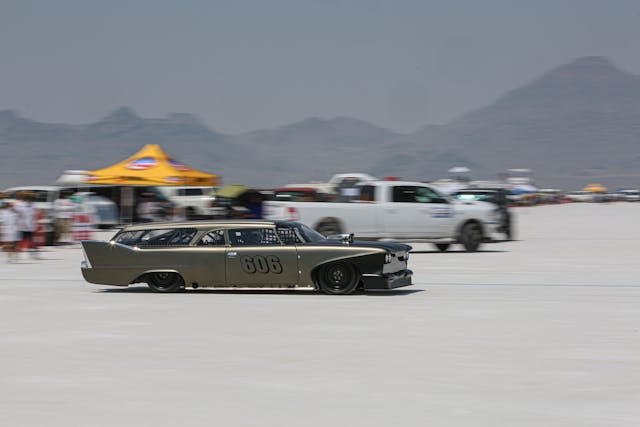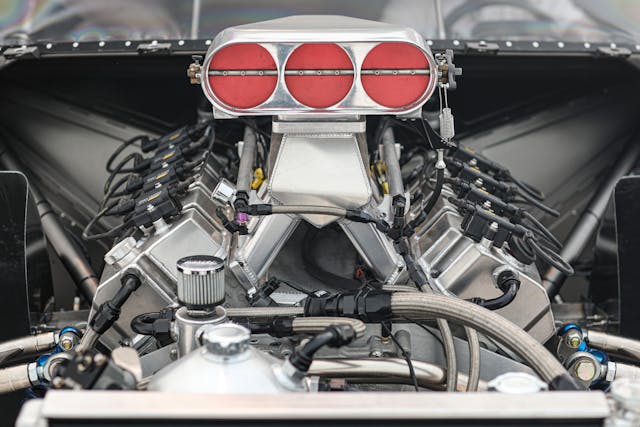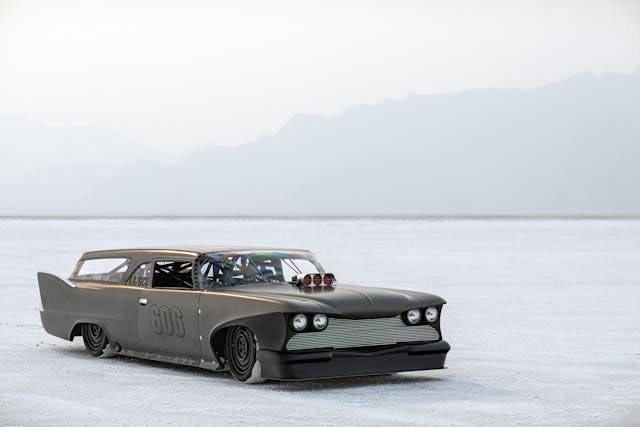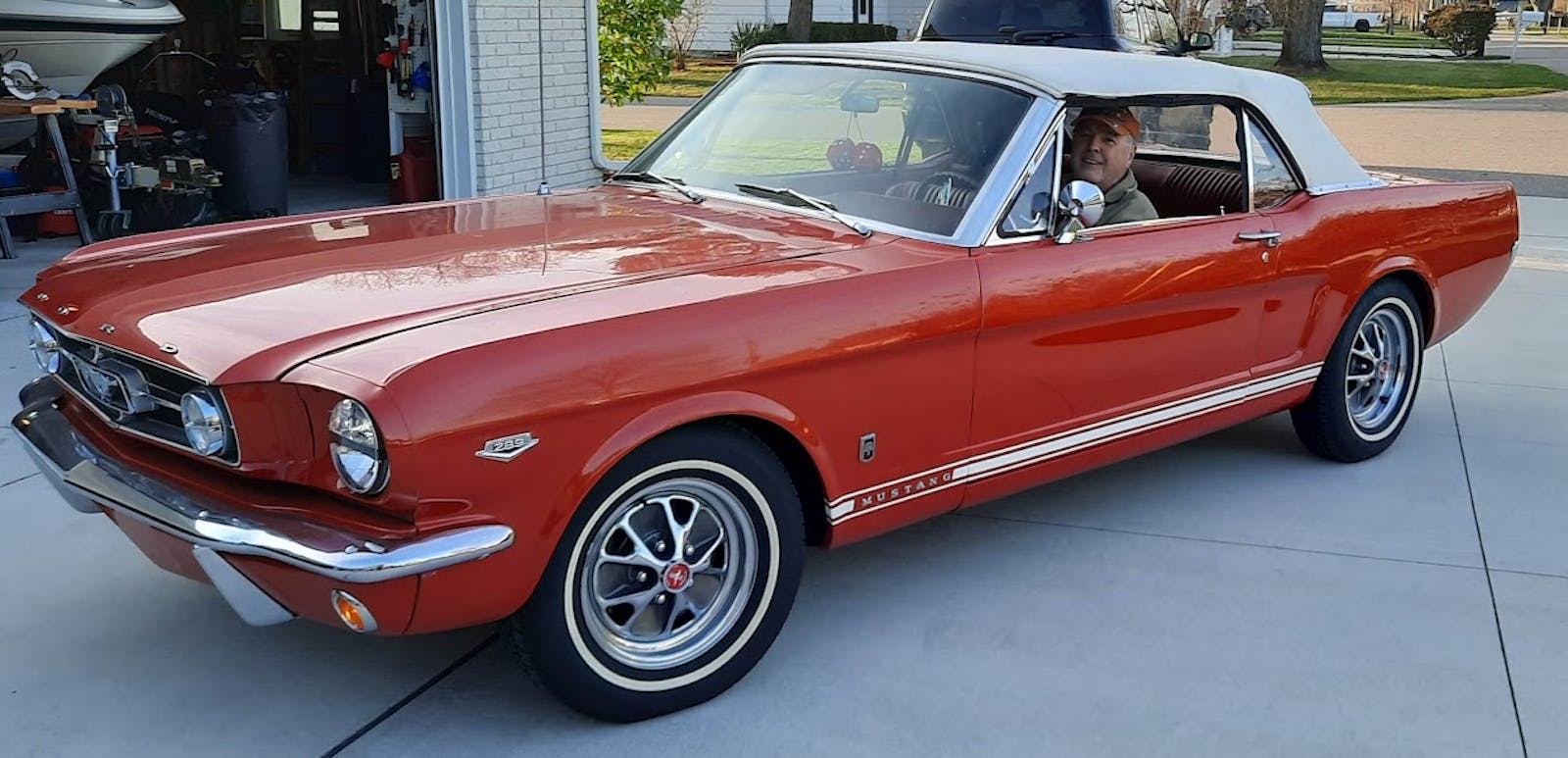The chopped-top Plymouth wagon aiming for 200 mph on the salt
All it takes is one trip to Speed Week to get Salt Fever. The longing to go back and race can take root and grow, absent any additional tending. For Greg Friedrich, who raced this 1960 Plymouth wagon on the salt for the first time at Speed Week in 2021, one trip about 20 years ago was enough. The stars eventually aligned to guide him back to Bonneville.

Friedrich, a native Minnesotan, had moved to California in the early 2000s. From his new home, a trip out to the salt at the Nevada/Utah border wasn’t that far, so he took advantage of his proximity to finally get out the land speed racing venue. Taking in the view and the sounds of the Bonneville staging lanes on his inaugural Speed Week, Friedrich noticed a ’34 Ford with something a bit strange mounted on the back. It was a license plate—not a common sight in the land of streamliners and lakesters. Even more interesting to Friedrich, the plate was from Minnesota. Friedrich introduced himself to the car’s owner, Tom Conlan, and learned that Conlan had driven the car to the salt, a 1400-mile pilgrimage. Conlan’s goal? Run in excess of 200 mph and then drive the car home.
After a few years living in California, Friedrich moved back to Minnesota where he started his own custom car building and fabrication shop called Gizmos. It wasn’t long before he had a new customer: Conlan. The two worked together on a few projects and really got along, so much so that Conlan asked Friedrich to take on the ’34 Ford race program. The two men did their best to get the ancient Henry Ford steel to eclipse 200 mph, but the unchopped windshield proved to be quite a burden, even when powered by a 572-cubic-inch Hemi. “Trying to push so much air, that thing didn’t want to go above 190,” Friedrich said.

Sadly, Conlan passed away in 2017, but his love of racing had been fully instilled in Friedrich, who decided that he need to build a race car of his own. Like the ’34, it needed to be street-driven. The unlikely vehicle Friedrich chose for his new project was a 1960 Plymouth wagon. He’d purchased the longroof while he was living in California and had intended to turn it into a hot rod, but at the time he didn’t think it would ever evolve into something like this.

Starting with the four-door wagon, Friedrich and his crew at Gizmos chopped the top three inches and converted it into a two-door. That involved a lot of welding and shaping on the quarter panel as well as lengthening the front doors by about eight inches. The overall wheelbase stayed the same. There are a lot of custom touches that a Mopar lover will recognize, including moving the headlights up inboard just a bit. The entire front end is one piece, which required quite a bit of fabrication, some of which was necessary for cleaning up the aerodynamics flowing down the side of the car. There’s also a custom grille and the front bumpers now integrate with a front splitter. Underneath is a custom belly pan and rear diffuser to help reduce drag and lift.

For an extreme build such as, Friedrich had to decide early whether it would be, “a street car that can race, or a race car that’s streetable.” He chose the latter, which meant that the car would lack a lot of everyday comforts, but with safety as a priority, there would need to be some sacrifices.

You’ve surely noticed that cage by now, evidence of the lengths to which this team prioritizes keeping Friedrich in one piece. The whole chassis was built from chromoly tubing and the extensive cage was meant to pass the stringent tech inspectors at Bonneville. The crew at Gizmos worked on the wagon for about two and a half years, which is a rather short build timeline considering that it was often behind on the to-do list in favor of paying customers’ projects. Still, Gizmos handled the bulk of the build aside from the engine and the paintwork. They got the car to Bonneville in time, but plans changed a bit and this year it made the trip on a trailer.

Wheeler Racing engines built the 528-cubic-inch fuel-injected Hemi. It uses Mopar cylinder heads and a Hogan sheet metal intake. Friedrich had wanted to build his own intake, but Hogan is proven to make power and was also able to whip one up and ship it out in less than two weeks as Bonneville was quickly approaching. The engine runs an AEM Infiniti ECU and produces about 800 horsepower on pump gas in a package that’s tame enough for the street. “It’s a safe engine that’s not living on the edge, Friedrich said. “It’s more than I need for what I want to do with the car. We kind of tuned it down a bit. We can always turn it up.”

So how did the big mill cut it on the car’s inaugural Speed Week? “It went really well. The car had little to no issues at all,” Friedrich reported. “My goal this year was to make it down the track.” The first hurdle, of course, was passing tech inspection. Inspectors want participants to race, but they need them to be safe. As such, new cars get an extra level of scrutiny. Typically new cars get two inspectors to do a thorough inspection, but Friedrich’s car was such a spectacle that it had five inspectors milling around checking it out. “They had zero issues with the car, so that was great. It’s nice to see that our hard work and research paid off.”

The car’s first pass was purely a shakedown run, and Friedrich wanted to hit 125 mph, which the car did without issue. At that point, he needed to establish a new goal. “I decided that if we could go 140 during Speed Week, I’d be pretty happy with that.” Back in the pits, the Gizmos team went over the car and everything seemed to be working as it should and Friedrich was pleased with the way the car had handled. Two more runs proved to be more of the same, with Friedrich pushing just a bit faster each time, making sure that the car felt right with the increasing aerodynamic loads. On the team’s fourth and final run of Speed Week 2021, Friedrich clocked 151.909 mph on the first timed mile and got it past 160 for a bit. “I held that for about a half-mile. That was at 4200 rpm. Then I pulled the chutes. I was happy. I was ready to go home.” Indeed, the speed over the next quarter mile backed up what Friedrich’s math told him: 160.615 mph. And that was at just 30-percent throttle.

The chopped wagon competes in the Competition Coupe class due to its body mods, which means the AA engine record Friedrich is running against is 293.857 mph, which isn’t even on his radar. “I liked the idea of building a street car, driving it out to Speed Week, and running 200 miles per hour.” Friedrich and the team of fabricators at Gizmos learned a lot about the car in its first Speed Week, and it performed well, with an extensive nut-and-bolt check of the car when it returned home showing only a shredded alternator belt. “Our goal of driving it out there and driving it 200 is in reach.”
If you want to see amazing race cars, and at least one street car, run on the salt, we can’t recommend Bonneville Speed Week enough. We hope to see you there next year as we follow Friedrich and his speedy longroof on the quest for 200 mph.



